ABC is a triangle in which ∠B = 2∠C. D is a point on side BC such that AD bisects ∠BAC and AB = CD. Prove that ∠BAC = 72°.
[Hint. Take a point P on AC such that BP bisects ∠B. Join P and D.]
Construction: Take a point P on AC such that BP bisects ∠B. Join P and D.
Proof: In ∆ABC,
∵ BP bisects ∠ABC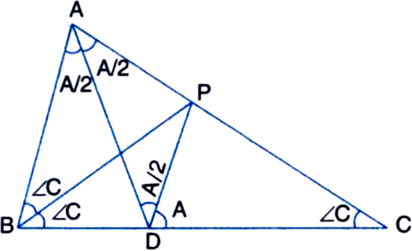
![]()
In APBC,
∴ ∠PBC = ∠PCB (= ∠C)
∴ PB = PC ...(2)
| Sides opposite to equal angles of∆PBC In ∆APB and ∆DPC,
AB = CD | Given
PB = PC | From (2)
∠ABP = ∠DCP (= ∠C)
∴ ∆APB ≅ ∆DPC | SAS Axiom
∴ ∠BAP = ∠CDP (= ∠A) ...(3)
| C.P.C.T.
and AP = DP ...(4) | C.P.C.T.
In ∆APD,
∵ AP = DP | From (4)
Again from ∆DPC,
∠DPC = π - (∠A + ∠C)
∴ ∠DPA = π - ∠DPC = π - {π - (∠A + ∠C)} = ∠A + ∠C ...(6)
From (5) and (6),
π - A = ∠A + ∠C ⇒ 2∠A + ∠C = π ...(7)
Again,
∠A + ∠B + ∠C = π
| ∵ The sum of three angles of ∆ABC = π ⇒ ∠A + 2∠C + ∠C = π | ∵ ∠B = 2∠C
⇒ ∠A + 3∠C = π ...(8)
Multiplying (7) by 3, we get
6∠A + 3∠C = 3π ...(9)
Subtracting (8) from (9), we get

A.
3 cmIn figure, ABCD is a square and ∠DEC is an equilateral triangle. Prove that
(i) ∆ADE ≅ ∆BCE
(ii) AE = BE
(iii) ∠DAE = 15°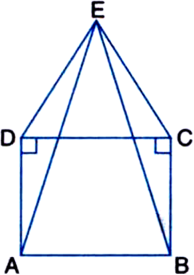
Given: ABCD is a square and ∆DEC is an equilateral triangle.
To Prove:
(i) ∆ADE ≅ ∆BCE
(ii) AE = BE
(iii) ∠DAE = 15°
Proof: (i) In ∆ADE and ∆BCE,
AD = BC
![]()
DE=CE
![]()
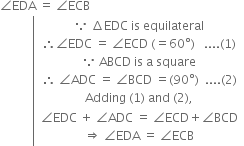
∴ ∆ADE ≅ ∆BCE | SAS congruence rule
(ii) ∵ ∆ADE ≅ ∆BCE | Proved in (1)
∴ AE = BE | CPCT
(iii) In ∆DAE,
∵ DE = DA | Given
∴ ∠DAE = ∠DEA ...(1)
| Angles opposite to equal sides of a triangle are equal Also, ∠ADE + ∠DAE + ∠DEA = 180°
| Angle sum property of a triangle
⇒ (∠ADC + ∠EDC) + ∠DAE + ∠DEA = 180°
⇒ (90° + 60°) + ∠DAE + ∠DEA = 180°
⇒ ∠DAE + ∠DEA = 30° ...(2)
From (1) and (2),
∠DAE = 15° = ∠DEA
Given: ABC is an equilateral triangle whose medians are AD, BE and CF.
To Prove: AD = BE = CF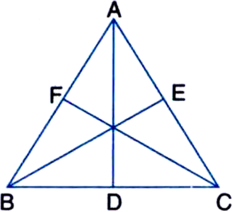
Proof: In ∆ADC and ∆BEC,
AC = BC
![]()
![]()

DE = EC
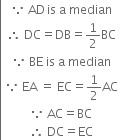
![]()
| SAS congruence rule![]()
![]() ....(1) | CPCT
....(1) | CPCT
Similarly, we can prove that
BE = CF ...(2)
and CF = AD ...(3)
From (1), (2) and (3)
AD = BE = CF
